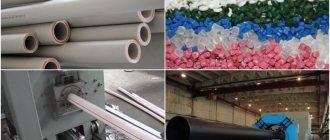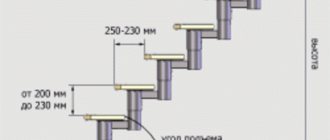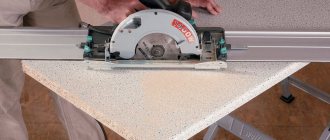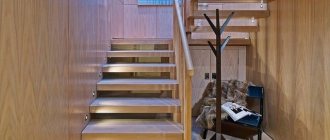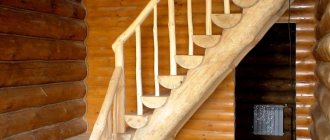For the staircase to the cellar, two types of construction are recognized:
The cellar is an important part of a private house, cottage, or garage. The owners use it to store preparations, harvests, tools, old products, and wine. The main stage in the arrangement of this space is the construction of a staircase structure. What material should the staircase to the cellar be made of and what are the features of the manufacturing process?
Please note that you cannot paint a staircase that has only recently been poured with concrete. The concrete must dry for 30 days, and only then can painting work begin.
Types of stairs
There are two types of stairs that people use
They are needed for the same tasks, but completely different in design. What are they?
- An ordinary staircase to the basement, an extension type. It is quite simple and its production is not difficult. The materials used for creation are wood or metal.
- Marching staircase - such structures are found in entrances, and it is recommended to purchase a finished product when creating a basement or cellar. It can be made of concrete, wood or metal.
The design of the latter is more complicated, but it is much safer than an extension ladder. Which type is better is up to each person to choose for himself. Everything will depend on skills, funds, free time and desire.
Manufacturing materials
Before starting the process of creating a staircase with your own hands, you need to select suitable materials for the structure. We invite you to learn about the features of each of the available materials:
Only in this way will the design be durable and reliable. If you use old metal for work, then you need to clean it in advance, remove traces of corrosion with an abrasive, and after manufacturing the stairs, cover them with anti-corrosion compounds. Alternatively, use enamel or oil-based paint in at least 3 layers.
Please note that you cannot paint a staircase that has only recently been poured with concrete. The concrete must dry for 30 days, and only then can painting work begin.
Wooden ladder
Video description
The creation of a concrete staircase is shown in the video.
The creation takes place in several steps:
- First they make the formwork. This is a special frame that holds the concrete while it hardens. Wood or plywood is used for formwork. “Steps” are knocked together from them and installed on supports. The latter are placed on the sides in the form of thick pillars, and stakes support the structure from below.
- Reinforcing mesh is laid inside the formwork. It serves to strengthen the structure.
- Cement is poured, leveled and left to dry.
After drying, the formwork is removed and the steps are sanded if necessary.
Calculation of the stairs to the cellar
When calculating the staircase, the requirements for it are taken into account, as well as ease of use, layout and size of the cellar. Be sure to draw a drawing on paper indicating all dimensions. According to the diagram, it is easier to assemble the structure with your own hands.
When calculating, the following parameters are taken into account:
Taking into account all the requirements, we begin to calculate a convenient staircase.
Wine drinks require special storage, because this affects their taste characteristics. Building a wine cellar is very popular.
Graphical calculation method
You can calculate the number of steps of a flight of stairs graphically. This method of calculation is distinguished by its ergonomics, since only natural parameters for a person are used in the calculations. Thus, the average step width on a horizontal surface is 62 centimeters, and the height is 31 centimeters.
We draw a coordinate system, set a unit segment on it, put 62 units on the abscissa (x) axis, and 31 units on the ordinate (y) axis. Connect the resulting dots. Then you need to draw a line that determines the angle of steepness of your structure. Find the intersection points of the resulting lines, and through them draw straight lines parallel to the axes of the coordinate system. Then draw a step diagram.
Using this method, you can determine the dimensions of any staircase structure from a drawing, regardless of the slope of the staircase, as well as measure the height and width of the staircase steps, and make adjustments to the scale.
To create a drawing, it is best to use graph paper or paper in a small square. When calculating the parameters of the steps, keep in mind that this is only a project, so you can adjust the data. For example, you can make a wider tread or make a beveled riser; this will make the design more convenient to use, but changing such parameters does not increase the safety of the device, since the design parameters of the device remain unchanged.
The safety of the stairs depends on the angle of steepness of the structure. Regardless of the fact that the permissible angle of inclination is in the range of 20-75°, the ideal option would be the rise of a flight of stairs with a steepness of 23-45°. If the slope angle is smaller, then it is recommended to construct a ramp instead of a staircase; if it is larger, the staircase must be made folding or attached.
When calculating the stairs, you need to take into account a number of factors
Features of building a wine cellar
Wine drinks require special storage, because this affects their taste characteristics. Building a wine cellar is very popular.
In such a room it is important to provide a thermal insulation system. Closed-porous materials are ideal for building a wine cellar. They are responsible for maintaining temperature.
The entrance door should be well sealed. Excessive air penetration will negatively affect the quality of the wine. Any materials are suitable for the floor, as long as they do not emit harmful chemical elements.
Drink bottles are stored horizontally and it is not recommended to move them. All necessary equipment must be of good quality using natural materials.
Construction must be carried out in compliance with all necessary instructions to avoid additional work and damage to the product.
The staircase to the cellar can be made with your own hands without much difficulty. Most often it is an attached structure, but there are also more complex models. Beauty is not important for the staircase, since it is hidden from public view. In its manufacture, the emphasis is on strength, convenience, and safety of use.
Metal staircase from corners
The metal staircase to the cellar is quite simple to make. To do this, you need to prepare a metal channel, 5-centimeter corners for steps, 1 mm thick metal sheets, an angle grinder, a welding machine, crushed stone and cement mortar, anti-corrosion impregnations and paint.
Sequence of work for metal stairs
Before starting work, it is necessary to perform all calculations on paper. Such drawings are important so that when cutting metal you do not have to change its dimensions. A grinder is used to cut the channel and angles into pieces of the required size. The frame for all stages is connected by welding. Experts recommend immediately removing the beads that form during welding; this is done with a grinder.
Mark a place to pour concrete on the floor. The pit is filled with crushed stone, filled with cement, and after the solution hardens, the structure must stand very firmly.
Sheets of metal are welded to the frame of the steps. Again, all sagging is protected, burrs and other defects are removed. Anti-corrosion impregnation and final painting are done. With such a coating, the storage descent can last for many years.
Pipe ladder
A small staircase can be made from metal pipes; this option is made very quickly, since all elements are connected by welding or an inverter. It is necessary to prepare pipes with a cross-section of 60 mm and crossbars with a round diameter of 3 cm. Measure 25 cm in the upper part of the pipe and fix the first step there.
The rest of the crossbars are assembled in the same way. All elements are connected by welding; if necessary, at this stage you can involve specialists who know the features of working with a welding machine.
A metal staircase to a cellar, a photo of which can be found in many manufacturer catalogs and freely available on websites, will become a reliable and safe option for descending if all stages of its assembly are correctly completed.
Staircase with concrete steps
The design of the descent with steps made of concrete is the most optimal option for cellars, since it is resistant to corrosion, does not sag over time, and will not creak under the weight of the products being carried. Installation is quite complicated, but it is done at the initial stage of building a house in conjunction with other work.
If you need to make such a staircase in an existing cellar, then you should prepare for a lot of work and serious expenses. It is necessary to make the correct calculations by calculating the amount of concrete mortar, boards and reinforcement.
It is important to calculate the height, width of the steps, slope, etc. The design is one-piece in its composition, so it will not be possible to make adjustments to maintain the work.
Manufacturing of formwork
To start work, you need to make a wooden formwork, a shell into which the concrete will be poured. The optimal material for this is plywood sheets with a thickness of 18 mm or more. The bottom of the structure must be reinforced with supports, since they will bear the weight of the entire structure. As a rule, boards or beams are used for this purpose.
They install sides that will prevent the solution from leaking out, and supports for the steps are attached to them. These crossbars create the final look of the entire staircase. The edges of the sides are reinforced with boards, which will give it additional rigidity. All wooden elements must be secured at their ends using reinforced metal corners
It is important to fix the lower steps especially tightly
Concreting
Before pouring the mixture, it is important to seal all joints with a solution of cement and sand. This procedure avoids changes and simplifies finishing work.
When mixing the solution, you need to carefully monitor the proportions of sand and cement.
To begin with, the first two steps are formed, which is very important for the correctness of the frame. To lay concrete in the formwork, you need to use rods that pierce the mixture to be poured to avoid voids
The concrete is also subjected to vibration by slightly shaking the structure or using a vibrating lath.
The surfaces of the steps are leveled with a spatula or trowel, giving them a finished look. This is done with all steps until the very end of the stairs.
Requirements for stairs to the cellar
When assembling stairs for a basement or cellar, the issue of aesthetics fades into the background. In a room with a specific purpose, the structure has other requirements:
An important requirement is durable material. It is easier to assemble the structure with your own hands from wood. However, such material quickly rots in damp conditions. As a last resort, it is better to use hard wood, such as oak or larch. Metal is considered the best material, but the assembly process is complicated by the need for welding. To protect steel from corrosion and wood from rotting, marching must be treated with protective impregnations and painted.
Some people prefer ready-made concrete slabs as the main material, while others pour them themselves and reinforce them directly above the room.
Materials used in the manufacture of stairs and their properties
The choice of material for any construction is a primary task, which determines the calculation of costs, complexity of application, and service life of the finished structure. The following materials are suitable for the stairs leading to the cellar:
- Wood is practical and easy to construct, but requires special treatment to extend its service life and protect it from harmful microorganisms. An inexpensive wood option is selected, which, when applied with an antiseptic and glazing composition, is protected from bacteria, bugs, and lichens. A variety of designs of varying complexity are created from wooden blocks, which implies the embodiment of interior fantasies.
- Metal – is highly durable and has a long service life. Metal stairs require protection against corrosion. Metal is not complete without painting. Based on its physical properties, the material is difficult to shape into the desired shape. The price of metal elements is low, implying independent production or purchase of a ready-made structure. Suitable for street descent, when the influence of water, snow, and dirt is possible.
- Concrete is distinguished by its high cost, durability with careful processing necessary to extend its service life. Concrete will serve as a good material when implementing interesting cellar staircase ideas. Not suitable for small spaces due to the large area. And also after construction, time is required for shrinkage (at least 30 days).
Having chosen an acceptable option, you should begin the calculations.
Cellar design process
A classic cellar is a rectangular-shaped room with a fairly low ceiling. For convenient entry, an additional hatch with concrete steps or a ladder is usually installed.
The option with a ladder is of course cheaper, but it is far from the most comfortable to use, since you will often have to go down to the cellar with various loads.
Making steps from brick or concrete is not at all difficult, but they will delight you with their reliability for many years.
When designing and viewing photos of a cellar dug by yourself, you need to take care of what materials will be used for the ceilings. In the near future, this will directly determine what width you can choose for the cellar.
Some people prefer ready-made concrete slabs as the main material, while others pour them themselves and reinforce them directly above the room.
- Reinforced concrete march
- Metal beams
General recommendations for constructing stairs
The question: “?” worries those people who are building a house without a project. Its presence saves the owner from such torment, since in the project, on the plans of each floor, the locations of the stairs are marked, and when the ceiling is installed, appropriate openings are immediately provided for in them.
However, even with a project, unforeseen situations happen. For example: as a result of an error, the entrance to the basement floor with a staircase is not provided at all, or it was not in the place where it was supposed to be. As a result, you have to make an opening in the already finished ceiling.
Opening for stairs
If the ceiling has a beam structure, everything is much simpler. The main thing here is that additional beams are installed around the perimeter of the hole. In the case of monolithic or prefabricated reinforced concrete floors, diamond cutting services are used to create openings.
Reinforcing an opening in a concrete floor
Beam ceiling: do-it-yourself staircase to the ground floor
So:
- Cutting the opening is carried out only after it has been reinforced with a steel angle or the supporting walls have been erected. It is advisable that the opening for the stairs be located along the load-bearing wall.
- In this case, the opening can be strengthened to a minimum, and it becomes possible to install not an inconvenient spiral staircase, but a marching staircase, or, say, a bolt staircase, which, due to its design, is attached only to the wall.
- In a basement floor covered with ceiling beams, their location is the guideline for placing the opening for the stairs. In general, before making an opening, you need to calculate its dimensions, or even better, order a design for the stairs to the ground floor.
Drawing with approximate dimensions of the flight of stairs
Note! The staircase from the ground floor to the house, like no other, requires strict compliance with building codes, because in the absence of windows or a separate exit, this is also the only way of evacuation from the premises in case of fire.
Basement staircase installed in cramped conditions
If you make the opening too small (1m*2m), then you can’t even dream of comfortable movement along the stairs. Of course, even in such a situation, you can build a staircase, providing instead of a landing in it a sharp turn of several steps tapering on one side. You can see a similar design in the photo above.
However, we note that although it looks beautiful, it is inconvenient and unsafe to use. This option is good only when combining apartments on two levels, which does not allow making a large opening in the ceiling.
In the basement floor, you can also provide a more convenient staircase, which requires an opening of at least 2m*3m. It may be more - but this depends on the type of staircase and the dimensions of the house.
Stair sizes
Ideally, the width of the stairs should not be less than 80 cm, or even better – 1 m, because you will not only have to walk on it, but also carry furniture.
So:
- For flights of stairs, the maximum slope should be 42 degrees.
- To make it comfortable to step on the steps, their width must be at least 250 mm.
- You can increase the depth of the tread by using the edge of an overhead wooden or ceramic step, the toe of which protrudes beyond the vertical plane of the riser.
- If the staircase is, say, metal, with glass steps, then this possibility will no longer exist.
Increasing tread depth due to protrusion
Note! The height of the risers is determined by calculation, and optimally it is 15-20 mm. It is important that the height of each step is the same, with an error of no more than 3 mm. The total span height is the distance between the finished floor marks of the upper and lower rooms.
The calculation is done like this:
- Let's say the height of the stairs for the basement is 295 cm, and you want to make steps 16 cm high.
- Dividing 295 by 16, you determine the number of steps - you get 18.44. Since this number is fractional, it should be increased to the whole number -19.
- An odd number of steps is considered the most convenient , since in this case a person stands on both the first and last step with the same foot.
- Then you need to adjust the height of the steps, dividing 295 now by 19 . As a result, you get a final step height of 15.5 cm.
Materials and tools for work
To build the stairs you will need the following materials:
- Reinforced concrete march
- Metal beams
Elements of a wooden structure (beam width 30-40 mm, and thickness no more than 25 mm) Waterproofing materials and antifungal agents should be used against exposure to negative external factors. To build a staircase, you need to prepare the following tools:
- Level
- Welding machine
- Drill
- Hammer
- Knife
- Hacksaw
- Level
- Roulette
The walls leading down to the basement are erected from concrete blocks or cast-in-place concrete. It is necessary to leave a small space between the ends of the staircase walls and the outer wall.
In the case where it is known that groundwater is exactly as close as possible to the selected surface, a drainage well must be dug. It is there that all excess water, as well as condensation, will accumulate in the future.
Stages of work
- Preliminary preparation for installing stair stringers. They can be installed in two ways:
- We determine the location of the structure, and in the place where its lower part will stand, we dig a hole 50 cm deep, its length and width depend on the size of the stairs (standard - 100x40 cm). Next, you need to fill the hole with crushed stone and cement so that the top 15 cm are left unfilled. The bottom edge of the stairs will be placed in this space and filled with concrete;
- we make the same hole. We install two reinforcement bars with a 12 mm cross-section and fill it with crushed stone. The upper edge of the reinforcing rod should be 25 cm higher than the hole. Fill the hole to the brim with cement.
- Installation. We screw two channels to the ceiling at a distance of 90 cm from each other. Depending on the chosen method, the lower edge of the channel is either poured with concrete or welded to the reinforcement bars. The base for the steps is made from the corners and welded from the inside to the channels.
- The last stage is processing. All protrusions must be removed and the metal is leveled in the right place. We cover the steps with either wood or metal sheets. We weld the railing from the outside to the channel. We treat the finished structure with an anti-rust agent and paint it.
The need to line the walls of the cellar
An important point is the process of covering the walls of the room. In most cases, concrete or brick is used. In this case, the solution is usually poured between the formwork and foundation pit.
Each of the methods can be done independently, provided that all the details are thought out in advance. For bricklaying you will need mortar and brick, and for a monolithic wall you will need to prepare material for spacers and formwork.
- 10 parts cement;
- 30 pieces of crushed stone (10 - 20 mm);
- 20 parts sand;
- 7 parts water.
Calculation of steps of a flight of stairs
In order for you to be able to move up the stairs without much effort, it is necessary that a number of rules be followed for each step. The first and main rule is that the width of the average human step corresponds to the height of the riser, as well as the width of the tread. This value is calculated using a direct relationship: 2a+b, where a is the height of the riser, b is the width of the tread.
It happens that the width is increased by about 2-3 cm to build more convenient deep risers. But this is a necessary measure and is required very rarely when there is no other method to make the tread wider.
To calculate the layout of a straight structure march, you need to find the product of the number of risers and the optimal tread width; to calculate the length of the base, you need to find the number of risers and their width.
After all the calculations have been completed, you can calculate the length of the structure and the number of steps. To do this, you need to divide the resulting number by the height of the riser. However, it must be remembered that the quotient of the division should not be a fractional number, since otherwise the heights of the steps will differ from each other, and this is unacceptable. If you still get a result with fractions, then the number should be rounded up to build a staircase with a steep climb, or, conversely, round down if you want to build a flatter structure.
To calculate the steps, you can also use another method, which is described below.
How to make a concrete staircase to the basement from the street with your own hands
Calculation of concrete stairs
We take the height of the step as 16 cm, and the depth as 30 cm. The number of steps can be determined by dividing the total height of the staircase by the height of the step. In this case, the topmost step can be made a few centimeters higher than the level of the yard. The threshold created in this way will serve as an additional barrier to rainwater.
Using a tape measure and a level, you need to mark the contours of future steps on the wall and select the soil in accordance with this drawing.
Next, you need to lay a water barrier made of polyethylene film. It is necessary so that the concrete does not draw moisture from the soil, and so that after pouring the concrete milk does not absorb into the soil, thereby reducing the strength of the solution.
An integral step in making a concrete staircase with your own hands is reinforcement. To do this, we insert reinforcement with a diameter of 8 mm into the wall. The longitudinal rods can be secured with thick wire, as shown in the photo, or welded. Thus, we have a rigid sheathing that will serve as a frame for the basement stairs.
Not only the safety of the garage owner when using the ladder, but also the service life of the product itself depends on how well the standards and production rules are met.
Calculation and installation
Before you start assembling the structure, it is important to make a drawing and make calculations. Although each staircase is made for a specific family, there are some generally accepted data. You should focus on them as the most convenient for people.
- The width of the structure is 90-100 cm;
- The width of the turning platform of double-flight stairs is 80 cm or more;
- The width of the steps depends on the residents: it should be comfortable for them to climb. It is better not to make them less than 25 cm;
- The height of the steps is 14-19 cm, optimally 17-18 cm.
DIY staircase
A certain part of home craftsmen are faced with the question “how to make a basement staircase in the garage”?
Technically, making a DIY basement staircase in your garage is not that difficult of a task. To manufacture the product, you will need boards of certain sizes (thickness - at least 40 mm; width - 150-200 mm). The length of the boards is selected based on the specified length of the stairs. To ensure reliable assembly of all elements, it is advisable to use wood screws (length - 800 mm; diameter - 6 mm).
Important! For side load-bearing elements and steps, try to choose a material without knots and cracks. In the presence of such defects, over time, the strength of the finished product decreases. This increases the risk of injury due to poor quality boards.
How to calculate the size of stair steps based on the riser height and tread width
To determine the parameters of the steps, you can use the “comfort rule” or the “safety rule”. In the first case, the width of the tread is subtracted from the height of the riser; in the second, the results are added up. However, when constructing a structure, it is better to rely on the optimal relationship between the values; for this, the result should not be within the limits of the values that are obtained as a result of mathematical operations when calculating both rules.
Also, when making calculations, you should take into account the location of the structure and its shape.
Creating formwork
The first step is to create a deck. This is the bottom of the stairs. It is made from a single sheet of waterproof plywood (WFP), 18 mm or more thick. The lower part is reinforced with supports, since it will bear the load from the entire structure. And these are all the elements and the weight of the concrete solution. Bars measuring 100x100 mm or boards measuring 50x150 mm are used as supports.
Then the flanging is done. It serves to prevent the flow of concrete mass, and also acts as a place for attaching supports for steps. The final appearance of the structure is formed by these cross members. The sides need to be reinforced with boards to make them rigid and reliable.
Boards for creating steps must be attached to the stringers through the ends. As an option, use reinforced metal corners. The bottom step needs to be strengthened best. All the load from other elements will be on it.
Here are some requirements for creating formwork:
- The fastening elements are exclusively self-tapping screws. With them, subsequent dismantling of the formwork will be much easier. Concrete steps will not be damaged.
- Since concrete will be poured into the formwork of the stairs, it is made very strong and stable. No shifts or damage should occur after filling with concrete mixture.
Pros and cons of using screw products
A spiral staircase to the attic or basement is a fairly common occurrence.
What are its advantages:
- The most important thing here is the compact size of the product. Installation of such structures does not require much space.
- A small spiral staircase does not need a large opening. Consequently, the area of the first floor is significantly saved.
- The cost of a simple product will be lower than a marching system.
- Most of the models can be easily manufactured and installed independently.
But there are also disadvantages to using such systems:
- It is quite inconvenient to move around the small circular structure.
- The compactness of the products does not allow large objects to be moved around them.
- Some models are quite difficult to install.
If we consider that a spiral staircase to an attic or attic is not used very often, then these negative aspects become not so important. Such products have many more advantages.
Reinforcement
Why do you need to reinforce the steps to the basement? Reinforced concrete structure is much stronger and more durable. With reinforcing bars, the steps will last ten years longer. Reinforcement is performed with metal rods 10–12 mm thick. They are tied into a mesh, the cell size of which is 100x120 or 150x200 mm. The bundle is made with soft wire. The reinforcement can be connected manually or using a special hook. To prevent the edges of the steps from crumbling during operation, these places are also reinforced with transverse reinforcement.
How to calculate winder steps: method for calculating a turning staircase
To save space in the cellar, you can use designs with winder steps. Such devices have an inner and outer edge that differ in width, making the transition along the steps smooth.
When calculating a rotating structure, it should be taken into account that along the narrow edge the width should not exceed 10 cm, and the overhang can be no more than 5 cm. Before performing calculations, you should divide the staircase into two identical parts, with 1 step in the middle.
The width of the tread along the narrow edge is initially set, then 4 points of the central step are found, which define the axes of symmetry. Find the intersection point, the resulting result will be the first point of proportional division.
To detect the second point, we connect the contours of the straight steps adjacent to the winders. As a result, we have 2 points that form a straight line. We divide this straight line into parts in the proportional ratio 1:2:3:4:5:6. We connect the resulting points.
Let's sum it up
Having assessed the whole situation, your strengths and skills, you can choose the staircase option that will be ideal in your case. Each type has its own advantages and disadvantages. For example, basement ladders can be moved and rearranged to any location if necessary. In addition, their creation will take several hours, and their cost is low. The downside is the safety and comfort of walking. In this regard, flight stairs are much better. But to implement the idea will require more money, time, effort and skills. Having made your choice, you can start working. And visual videos will help you navigate the process of creating a cellar staircase.
Recommended Posts
DIY formwork for concrete stairs
Stairs for the terrace
How to make a metal staircase with your own hands
DIY staircase
Staircase on metal stringers
How to make a porch on the veranda with your own hands


